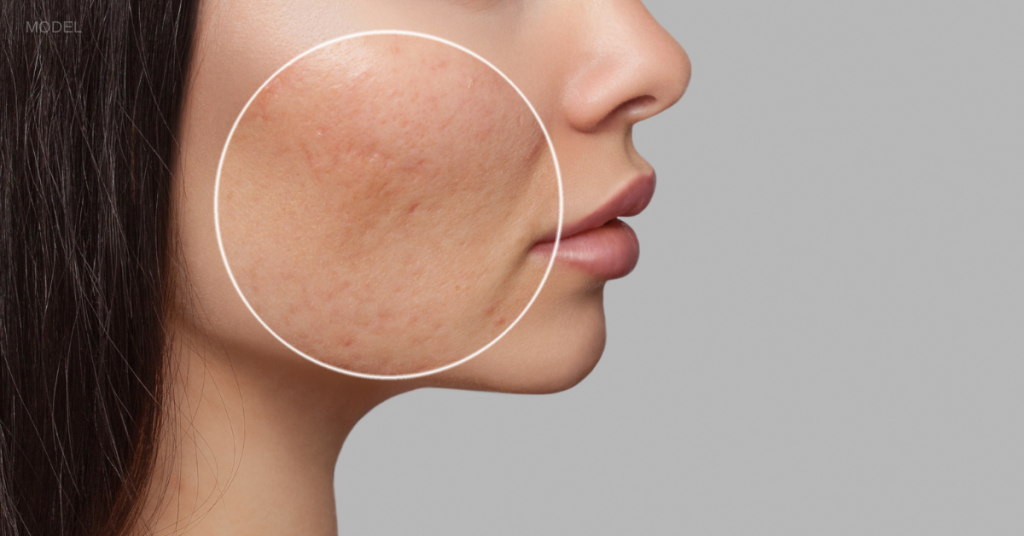
30
Mar
WHAT IS THE MOST EFFECTIVE TREATMENT FOR ACNE SCARS?

If you have struggled with acne on your face or body, you may be left with scarring once the lesions heal. While acne scars are typically not painful, they can make you uncomfortable and negatively impact your self-esteem. Although topical gels or patches can improve some acne scarring, effective acne scar treatments often require more professional solutions.
What Are Common Types of Acne Scars?
The appearance of your scars can differ based on your type of acne.
Atrophic scars. These scars are usually flat, shallow depressions on the skin’s surface, affecting about 80% to 90% of people with acne scarring. Often caused by cystic acne, atrophic scars generally fall within 3 categories:
- Boxcar scars – Broad, box-shaped scars with defined edges.
- Ice pick scars – Narrow indentations that typically occur on the cheeks.
- Rolling scars – Appear as pits and indentations on the skin.
Hypertrophic and keloidal scars. Hypertrophic scars are raised, pink scars; keloid scars are raised, red or purplish scars. Both are caused by an excess of collagen deposits in the lesion area.
Treatments That Can Improve Acne Scars
Your dermatologist will assess your acne scars and recommend the best treatment based on your skin type.
Laser Treatment
Lasers are considered the most effective for improving the appearance of acne scars, particularly boxcar and rolling scars. Ablative, fractional lasers usually work best, depending on your scar’s size, thickness, and age. The Lumenis UltraPulse CO2 laser can be used in full or fractional ablative mode to resurface your skin and stimulate the growth of new skin cells.
After an UltraPulse CO2 laser treatment, you will see immediate improvements to your acne scars, although the full results won’t emerge for several months. After 2 weeks of initial recovery, you can use makeup to cover up redness or swelling on your skin.
Non-ablative fractional resurfacing, with Fraxel(R) and/or ResurFx laser therapy can also be very helpful when treating acne scars.
Intense Pulsed Light (IPL, M22 Stellar) can also employed to improve the redness of stubborn scars.
Chemical Peels
Chemical peels are excellent options for improving acne scarring. This facial treatment uses medical-grade acids, such as salicylic, trichloroacetic, or glycolic acid, and other substances to remove damaged skin cells.
A chemical peel can improve several types of acne scarring, including pockmark scars, and post-inflammatory discoloration caused by pustules or pimples. People with ice pick and rolling scars will usually need a series of chemical peels and at-home treatments to achieve the results they want. Depending on the strength of the peel, you may need a week or two of recovery time.
At Essential Dermatology we also employ the use of phenol peels for a certain technique called “CROSS”. This is especially helpful for ice-pick and box-car scars.


Subcision
Subcision is a performed to help release the scarring from underneath the skin. Acne scarring is not just skin-surface; the scars include webbing that extends into the deep dermis and below. In order to release the scars, and help smoothen the skin texture, subcision is often performed in combination with the other treatments (peeling, laser, filling). When performing subcision, a needle and/or a blunt probe is introduced into the deeper layers of the skin, and with repetitive strokes the deeper webs of acne scars are disrupted and released.
Microneedling
Microneedling improves acne scars by creating controlled injuries in the skin to stimulate the body’s natural healing process. This treatment works on boxcar, ice pick, and rolling scars and can reduce scar depression. Although microneedling can give you long-lasting results, you may need repeat sessions to maintain your results.
At Essential Dermatology, we combine traditional microneedling with radiofrequency waves, called RF microneedling, to improve scarring and stimulate collagen production. RF microneedling is safe for all skin types and tones.
Although you can’t completely erase acne scars, the above treatments can make them less visible. Not everyone will have the same result after acne scar treatments, so talk to a dermatologist about the best options for your scars. To learn more about acne scar treatment, request a consultation or call us at (508) 827-2615 to schedule an appointment.
